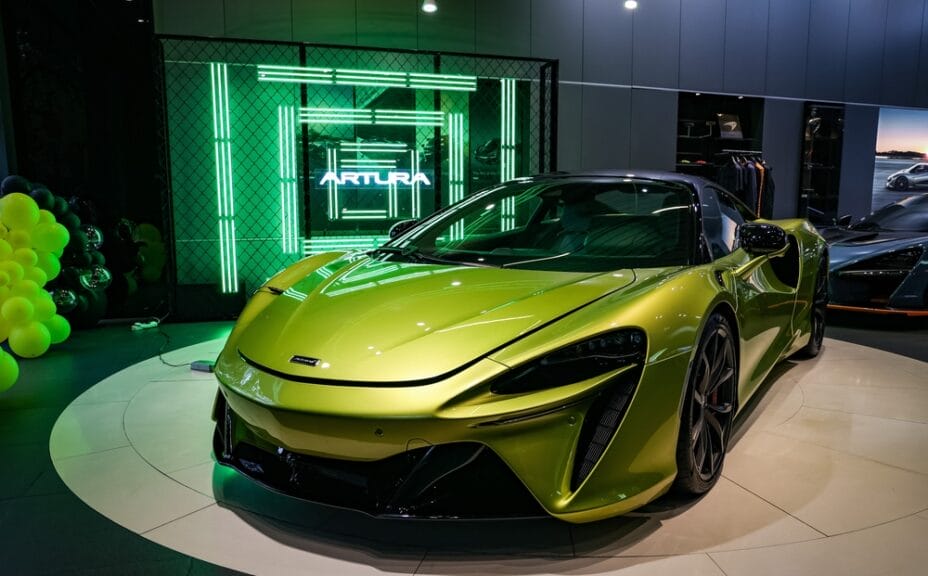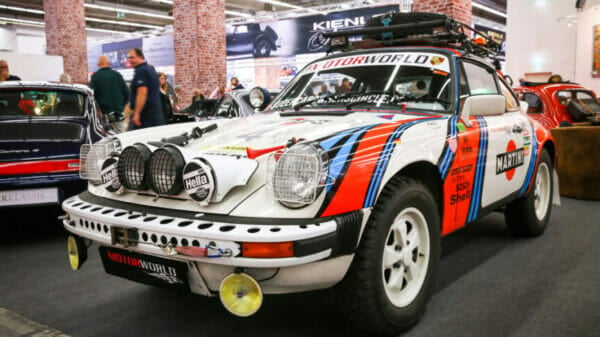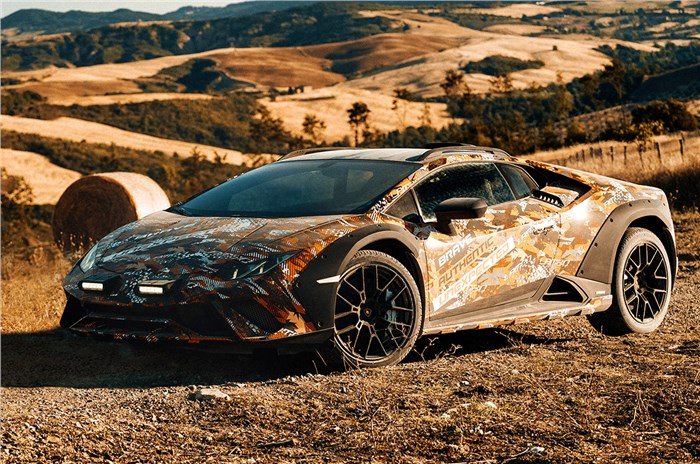Mclaren has a long history of leading innovation in the world of supercars. Since the establishment of McLaren Automotive in 2010, they have consistently introduced new sports models, super models, or ultimate models every year without fail. The 2025 Artura Spider continues this tradition by being the first drop-top hybrid developed at the Woking UK headquarters. Although a 2025 model, it occupies the 2024 position in McLaren’s supercar lineup.
What distinguishes the Artura Spider from its predecessors such as the 12C, 570S, 650S, 720S, and 750S is that it is the first among them to feature less than 8 cylinders. The engine, designed in collaboration with McLaren Racing’s Formula One division, boasts one of the most technologically advanced V6 engines globally. To further enhance its performance, it is equipped with a hybrid assist motor named the Axial Flux E-Motor System, which delivers instant torque and additional power throughout the rev range while also replacing the conventional reverse gear.
The Artura Spider not only features a high-tech powertrain but also incorporates numerous advancements in systems technology and composite materials. Many of these innovations have been transferred to the Coupe version, making the 2024+ Artura Coupe almost a revised version of the original 2022 model. The introduction of the McLaren Carbon Lightweight Architecture (MCLA) is a significant development, resulting in both the Artura Spider and Coupe being among the lightest full Sport Series models ever produced at the McLaren Technology Center (MTC). The Spider weighs a mere 1,560 kg (3,439 lbs), making it remarkably lightweight.
Despite the inclusion of additional carbon tub stiffening and mechanisms to retract the power hardtop, the Spider weighs only 62 kg (137 lbs) more than the Coupe. To provide context, this means the Artura Spider is just 70 kg (154 lbs) heavier than McLaren’s pioneering performance hybrid, the P1 Hypercar. With two-thirds of the horsepower of the P1, the Spider stands out as McLaren’s lightest convertible to date and is also one of the fastest, boasting a 0 to 60 time of just 3.0 seconds.
The 2025 McLaren Artura Spider, despite being considered a basic model in the McLaren lineup, is a high-performance supercar. The engineers at the McLaren Technology Centre have collaborated with the McLaren Racing Formula One team to develop a pioneering engine for the Artura Coupe, which has now been fine-tuned for the Artura Spider. This exceptional V6 engine, named the M630 twin-turbocharged 120-degree V6, is the first of its kind in an open-top supercar worldwide. For the Spider model, McLaren has enhanced the engine further.
The powertrain delivers 597 HP at 7,500 RPM and 431 lbs-ft of torque at 2,250 RPM, which is a 20 HP increase over the V6 in the Coupe. This power boost is primarily due to the engine’s all-aluminum build and “hot-vee” turbocharger design. The “hot-vee” layout alters the traditional intake and exhaust port configuration by directing compressed air into the sides of the engine and exhaust gases into the V of the engine banks. This setup accelerates the turbochargers’ response time, resulting in improved throttle response.The 2025 McLaren Artura Spider is quite impressive due to its design that allows the power-folding hard top to fold away over the engine without affecting engine cooling or air intake. The engine is positioned low, and with a top that doesn’t extend upward much, there is sufficient air space for the four air intakes to supply enough cooling air to keep the engine operating efficiently.
The McLaren Axial Flux E-Motor System, despite its complex name, delivers 94 HP and an extra 166 lbs-ft of torque starting from 0 RPM. Comparing it to the McLaren P1 hybrid motor, the power density per kilogram is 33% higher, showcasing a significant improvement.
The 2025 McLaren Artura Spider hybrid car utilizes its hybrid system throughout its entire speed range, from a standstill to a top speed of 330 KPH (205 MPH). An interesting weight-saving measure includes the Spider’s dual-clutch transmission featuring only 8 forward gears and no reverse gear. Instead, the E-Motor can reverse polarity, effectively acting as the reverse gear. Moreover, with insights gained from the coupe model and advancements in transmission technology, the Spider’s gear shifts are almost seamless, transitioning 25% faster than the Coupe model.
The total combined power output from both the engine and the hybrid system reaches a flat 700 PS, which equals 691 HP. The combined torque produced is an impressive 531 lbs-ft. In a customer-friendly move, McLaren offers a complimentary upgrade of 20 HP to Artura Coupe owners seeking the extra power.
Regarding chassis and handling, the Artura Spider closely mirrors its Coupe counterpart in terms of driving dynamics. It stands out in its class as the sole supercar to blend the advantages of ultra-lightweight carbon composite construction, a mid-engine configuration with rear-wheel drive, and an e-Motor for immediate throttle response. Notably, the Spider employs an electronically-controlled hydraulic assist system for steering, departing from the modern electric-assist systems in most supercars. This means drivers experience instant feedback and excellent sensitivity to the position and behavior of the front wheels, creating a harmonious blend of cutting-edge technology with the timeless appeal of traditional driving sensations.
The McLaren Artura Spider incorporates advanced technology in its rear differential, which differs from a traditional mechanical one. The car uses electronic controls to adjust the slip between the rear axle shafts based on factors like angle, speed, driving mode, and aggressiveness. By doing so, it can optimize power delivery to the wheel that needs it most, especially in situations like a hairpin turn where extra torque is essential.
The McLaren Artura Spider is designed to achieve a balance between increased agility and stability, providing superior dynamics.
To enhance stability during high-speed cornering, McLaren invested in wind tunnel testing and computational fluid dynamics to optimize the car’s aerodynamics and suspension system, ensuring maximum performance on the road.The Artura Spider utilizes passive aerodynamics rather than active aerodynamics like many of its competitors. It includes louvered front wheel arches to reduce air pressure in the wheel wells and slim brake cooling duct intakes under the headlights.
At the rear, the shape of the Spider along with the diffuser creates 110 kg (243 lbs) of downforce, which helps keep the rear wheels firmly on the road. Additionally, the front splitter channels air underneath the car to create a low-pressure “air skirt,” enhancing front-end grip.
The suspension setup of the Artura Spider plays a crucial role in its performance. It features Proactive Damping Control (PDC) that responds 90% faster than the Coupe model. This enhanced suspension system allows the Spider to handle turns more effectively, even outperforming the Coupe in certain driving modes, a rarity for convertible supercars.
This is a picture of the 2025 McLaren Artura Spider. The car has a fully independent suspension at each corner and shares a carbon composite “tub” with the Coupe model. This tub is very advanced and has minimal torsional flex, ensuring the suspension keeps the tires on the road for flat cornering.
There are three driving modes in the McLaren Artura Spider named Comfort, Sport, and Track. Each mode adjusts various parameters for the car, such as damping for urban driving, stiffness for track performance, e-differential slip control, and traction/stability systems intervention.
McLaren allows separate control of electronic stability control (ESC) and traction control (TC) settings in the Artura Spider. ESC settings include On, Dynamic, and Off, while TC settings offer Handling and Powertrain modes, giving drivers more flexibility in managing traction control during different driving conditions.Too much power is restrained or controlled during a high-speed sprint to prevent wheel spinning completely.
Overall, the vehicle dynamics system in the Artura Spider by McLaren is highly customizable, making it stand out among supercars.
Brakes & Tires
The Artura Spider boasts formidable brakes to match its powerful performance. Equipped with 390mm front and 380mm rear carbon ceramic discs controlled by 6 piston calipers at the front and 4 piston calipers at the back, along with an electronically managed vacuum-type brake booster, this supercar can go from 200 KPH to a complete stop in just 124 meters. This exceptional braking capability rivals that of a race car, setting a new standard for braking distance in supercar Spiders of 2024. Impressively, despite being a hybrid, the Artura Spider relies solely on traditional pad-to-disc braking and does not utilize regenerative braking technology.
Partnered with Pirelli, the Artura Spider features custom-made P-ZERO MC-C tires specially designed for optimal road performance. These tires, sizes 235/35Z R19 at the front and 295/35Z R20 at the rear, belong to the Pirelli P-ZERO Cyber Tire family, resembling semi-slick tires approved for road use. Known for their exceptional water dispersion capabilities, these tires provide superior traction in varied weather conditions.
Two optional tire variants are also available directly from the factory. The Pirelli P-ZERO Corsa tire features a softer compound ideal for maximizing grip on track surfaces while remaining suitable for dry road conditions. Alternatively, the Pirelli P-ZERO Winter tire boasts a unique tread pattern and siping for enhanced traction on icy or snow-covered roads.
Design, Styling & Interior
Following the tradition of Spider models, the Artura Spider incorporates two flying buttresses located behind each seat to enhance airflow over the engine cover louvres, aiding in heat dissipation before passing over the rear of the car. Additionally, the aerodynamic “speed bumps” behind the seats contribute to the vehicle’s stability and minimize air turbulence within the cabin.
The interior of the car captures the essence of McLaren, featuring a minimalist design with an alcantara-covered steering wheel and a clear, user-friendly TFT screen for essential functions. The McLaren Infotainment System 2 (MIS-II) screen in the center of the console provides access to various car settings and Advanced Driver Assistance Systems (ADAS). The cabin is uncluttered with only necessary controls like a knob for driving modes and other essential buttons, emphasizing simplicity and focus on driving experience typical of McLaren.
The 2025 McLaren Artura Spider has a sleek design that is classic McLaren style, with a longer and lower shape compared to previous models. It features signature curve shapes and various airflow elements on the exterior to optimize performance.
This model offers an extensive range of paint options, including elite, standard, and custom colors to choose from. Owners can even request a color-match to a sample they provide to McLaren’s team.
In terms of pricing, the MSRP for the 2025 McLaren Artura Spider is £221,500, which is about $284,655. For an additional $6,500, buyers can customize the interior with either TechLux for a focus on luxury and technology or Vision for advanced materials and a modern aesthetic.The 2025 McLaren Artura Spider comes with a standard five-year unlimited mileage warranty, a six-year 75,000 KM/45000-mile battery warranty, and a ten-year anti-perforation warranty, all of which are extendable. Additionally, it includes a three-year service plan and a five-year roadside assistance package.
Image Source: Jack Skeens / Shutterstock












